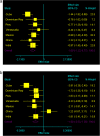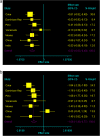The association of dementia with upper arm and waist circumference in seven low- and middle-income countries: the 10/66 cross-sectional surveys
- PMID: 22389465
- PMCID: PMC3403862
- DOI: 10.1093/gerona/glr244
The association of dementia with upper arm and waist circumference in seven low- and middle-income countries: the 10/66 cross-sectional surveys
Abstract
Background: Weight loss in dementia contributes to morbidity and mortality but the distribution of anthropometric change and its consistency between populations are less clear. Our aim was to investigate and compare the associations of dementia with waist and upper arm circumference in elders from seven low- and middle-income nations.
Methods: Cross-sectional surveys were conducted of 15,022 residents aged 65 years and older in Cuba, Mexico, Venezuela, Peru, Dominican Republic, China, and India. Dementia was assessed using a cross-culturally validated algorithm, and anthropometric measurements were taken. Associations with dementia and dementia severity (clinical dementia rating scale) were investigated in linear regression models, with fixed-effects meta-analyses used to investigate between-country heterogeneity.
Results: Dementia and increased dementia severity were both associated with smaller arm and waist circumferences with little evidence of confounding by sociodemographic and health status. Associations between dementia/clinical dementia rating and arm circumference were homogeneous between countries (Higgins I(2) 0% and 7%, respectively), whereas those with waist circumference were more heterogeneous (Higgins I(2) 67% and 62%, respectively).
Conclusions: Although cross-sectional, our findings are consistent with prospective observations of weight loss in dementia and suggest loss of both muscle and fat-the former being consistent across different settings and the latter being more context dependent.
Figures


Similar articles
-
Dementia severity and weight loss: a comparison across eight cohorts. The 10/66 study.Alzheimers Dement. 2013 Nov;9(6):649-56. doi: 10.1016/j.jalz.2012.11.014. Epub 2013 Mar 7. Alzheimers Dement. 2013. PMID: 23474042 Free PMC article.
-
Leg length, skull circumference, and the prevalence of dementia in low and middle income countries: a 10/66 population-based cross sectional survey.Int Psychogeriatr. 2011 Mar;23(2):202-13. doi: 10.1017/S1041610210001274. Epub 2010 Aug 12. Int Psychogeriatr. 2011. PMID: 20701817 Free PMC article.
-
Dementia and lower blood pressure in Latin America, India, and China: a 10/66 cross-cohort study.Neurology. 2013 Jul 16;81(3):228-35. doi: 10.1212/WNL.0b013e31829bfe66. Epub 2013 Jun 14. Neurology. 2013. PMID: 23771488 Free PMC article.
-
Development of a brief assessment and algorithm for ascertaining dementia in low-income and middle-income countries: the 10/66 short dementia diagnostic schedule.BMJ Open. 2016 May 25;6(5):e010712. doi: 10.1136/bmjopen-2015-010712. BMJ Open. 2016. PMID: 27225649 Free PMC article.
-
Association of anthropometry and weight change with risk of dementia and its major subtypes: A meta-analysis consisting 2.8 million adults with 57 294 cases of dementia.Obes Rev. 2020 Apr;21(4):e12989. doi: 10.1111/obr.12989. Epub 2020 Jan 3. Obes Rev. 2020. PMID: 31898862 Free PMC article. Review.
Cited by
-
Aging-induced dysregulation of dicer1-dependent microRNA expression impairs angiogenic capacity of rat cerebromicrovascular endothelial cells.J Gerontol A Biol Sci Med Sci. 2013 Aug;68(8):877-91. doi: 10.1093/gerona/gls242. Epub 2012 Dec 13. J Gerontol A Biol Sci Med Sci. 2013. PMID: 23239824 Free PMC article.
-
Dementia severity and weight loss: a comparison across eight cohorts. The 10/66 study.Alzheimers Dement. 2013 Nov;9(6):649-56. doi: 10.1016/j.jalz.2012.11.014. Epub 2013 Mar 7. Alzheimers Dement. 2013. PMID: 23474042 Free PMC article.
-
Associations of Upper Arm and Thigh Circumferences with Dementia and Depression in Korean Elders.Psychiatry Investig. 2017 Mar;14(2):150-157. doi: 10.4306/pi.2017.14.2.150. Epub 2017 Mar 6. Psychiatry Investig. 2017. PMID: 28326112 Free PMC article.
-
Association of Grip Strength, Upper Arm Circumference, and Waist Circumference with Dementia in Older Adults of the WiSE Study: A Cross-Sectional Analysis.J Nutr Health Aging. 2016;20(10):996-1001. doi: 10.1007/s12603-015-0643-4. J Nutr Health Aging. 2016. PMID: 27925139
-
Waist Circumference and Domain-Specific Cognitive Function Among Non-Demented Japanese Older Adults Stratified by Sex: Results from the Takashima Cognition Study.J Alzheimers Dis. 2020;73(3):887-896. doi: 10.3233/JAD-190395. J Alzheimers Dis. 2020. PMID: 31884460 Free PMC article.
References
-
- White H, Pieper C, Schmader K. The association of weight change in Alzheimer's disease with severity of disease and mortality: a longitudinal analysis. J Am Geriatr Soc. 1998;46(10):1223–1227. - PubMed
-
- Knoops KT, Slump E, de Groot LC, Wouters-Wesseling W, Brouwer ML, van Staveren WA. Body weight changes in elderly psychogeriatric nursing home residents. J Gerontol A Biol Sci Med Sci. 2005;60(4):536–539. - PubMed
-
- Shatenstein B, Kergoat MJ, Nadon S. Anthropometric changes over 5 years in elderly Canadians by age, gender, and cognitive status. J Gerontol A Biol Sci Med Sci. 2001;56(8):M483–M488. - PubMed
-
- Knopman DS, Edland SD, Cha RH, Petersen RC, Rocca WA. Incident dementia in women is preceded by weight loss by at least a decade. Neurology. 2007;69(8):739–746. - PubMed

